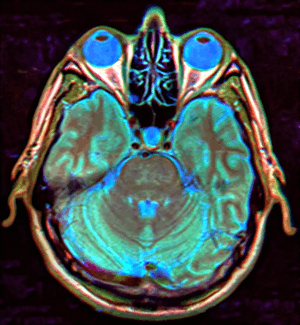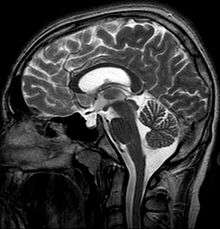Empty sella syndrome
| Empty sella syndrome | |
|---|---|
 | |
| Classification and external resources | |
| ICD-9-CM | 253.8 |
| DiseasesDB | 31523 |
| MedlinePlus | 000349 |
| MeSH | D004652 |

Empty sella syndrome (abbreviated ESS) is where the pituitary gland shrinks or becomes flattened,[1] filling the sella turcica, or "Turkish Saddle", with cerebrospinal fluid on imaging instead of the normal pituitary. ESS can be found in the radiological workup of pituitary disorders, or as an incidental finding when imaging the brain.
Classification
There are two types of ESS: primary and secondary.
- Primary ESS happens when a small anatomical defect above the pituitary gland increases pressure in the sella turcica and causes the gland to flatten out along the interior walls of the sella turcica cavity. Primary ESS is associated with obesity and high blood pressure in women. The disorder can be a sign of idiopathic intracranial hypertension.
- Secondary ESS is the result of the pituitary gland regressing within the cavity after an injury, surgery, or radiation therapy. Individuals with secondary ESS due to destruction of the pituitary gland have symptoms that reflect the loss of pituitary functions, such as the ceasing of menstrual periods, infertility, fatigue, and intolerance to stress and infection.
Associated conditions and diagnosis
ESS may be associated with early onset of puberty, growth hormone deficiency, pituitary tumors, or pituitary gland dysfunction. ESS has also been found to be linked with low testosterone or Hypogonadism in men.
MRI scans are useful in evaluating ESS and differentiating it from other disorders that produce an enlarged sella.
Differential diagnosis
The major differential to consider in empty sella syndrome is intracranial hypertension, of both unknown and secondary causes, and an epidermoid cyst, which can mimic cerebrospinal fluid due to its low density on CT scans, although MRI can usually distinguish the latter diagnosis.[2]
Treatment
Unless the syndrome results in other medical problems, treatment for endocrine dysfunction associated with pituitary malfunction is symptomatic and supportive. In some cases, surgery may be needed.
References
- ↑ Wisse, Brent (Last reviewed on 11/7/2013). "Empty sella syndrome". University of Maryland Medical Center. Check date values in:
|date=(help) - ↑ González-Tortosa, J (2009). "Primary empty sella: Symptoms, physiopathology, diagnosis and treatement". Neurocirugia (Asturias, Spain). 20 (2): 132–51. PMID 19448958.
External links
- emptysella at NINDS